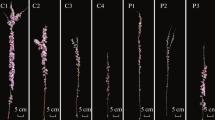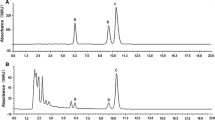Abstract
Ancymidol foliar spray at 132 mg·liter−1 a.i. modified leaf anatomy of developing Helianthus annuus L. ‘Mammoth Russian’ leaves, but not of mature leaves. Ancymidol was effective in retarding plant growth when applied at the young seedling or at a more mature stage of growth. Ancymidol increased leaf weight per unit area and chlorophyll content on an area and unit weight basis, regardless of stage of leaf development. Total chlorophyll per leaf was also increased in mature leaves. Thus, darker green foliage due to increased chlorophyll content and modified leaf anatomy responses were determined to be independent effects.
Similar content being viewed by others
References
Armitage AM, Hamilton BM and Cosgrove D (1984) The influence of growth regulators on gerbera daisy. J Amer Soc Hort Sci 109: 629–632
Bishop P and Whittingham CP (1961) Gibberellic acid and chlorophyll content of leaves of meteor peas. Nature 192: 576–577
Brian PW and Hemming HG (1955) The effect of gibberellic acid on shoot growth of pea seedlings. Physiol Plant 8: 669–681
Bunce JA, Patterson DT, Peet MM and Alberte RS (1977) Light acclimation during and after leaf expansion in soybean. Plant Physiol 60: 255–258
Cathey HM (1975) Comparative plant growth-retarding activities of ancymidol with ACPC, phosfon, chlormequat and SADH on ornamental plant species. HortScience 10: 204–216
Coolbaugh RC, Hirano SS and West CA (1978) Studies on the specificity and site of action of ancymidol, a plant growth regulator. Plant Physiol 62: 571–576
Dengler NG (1979) Comparative histological basis of sun and shade leaf dimorphism in Helianthus annuus. Can J Bot 58: 717–730
Halfacre RG, Barden JA and RollinsJr HA (1969) Effects of Alar on morphology, chlorophyll content, and net CO2 assimilation rate of young apple trees. Proc Amer Soc Hort Sci 97: 40–52
Humphries EC (1968) Effects of (2-chloro-ethyl) trimethyl-ammonium chloride on plant growth, leaf area, and net assimilation rate. Ann Bot 27: 517–532
Johnansen DA (1940) Plant Microtechnique, 27–94; 126–154. New York: McGraw-Hill
Joiner JN, Poole RT, Johnson CR and Ramcharam C (1978) Effects of ancymidol and N, P, K on growth and appearance of Dieffenbachia maculata ‘Baraquiniana’. HortScience 13: 182–184
McConnell DB and Struckmeyer BE (1971) The effect of succinic acid, 2,2-dimethyl hydrazide on the anatomy of Tagetes erecta L. J Amer Soc Hort Sci 96: 70–73
Moran R (1982) Formulae for determination of chlorophyllous pigments extracted with N,N-dimethylformamide. Plant Physol 69: 1376–1381
Moran R and Porath D (1980) Chlorophyll determination in intact tissues using N,N-dimethylformamide. Plant Physiol 65: 478–479
Read PE and Fieldhouse DJ (1970) Use of growth retardants for increasing tomato yields and adaptation for mechanical harvest. J Amer Soc Hort Sci 95: 73–78
Reid JB, Murfet IC and Potts WC (1983) Internode length in Pisum. II. Additional information on the relationship and action of loci Le, La, Cry. Na, and Lm. J Exp Bot 34: 349–364
Steer MW (1981) Understanding Cell Structure, 21–66. New York: Cambridge University Press
Stoddart JL (1965) Chemical changes in Lolium temulentum L. after treatment with (2-chloroethyl) trimethylammonium chloride (CCC). J Exp Bot 16: 604–613
Tezuka T, Sekiya H and Ohno H (1980) Physiological studies on the action of CCC in Kyoho grapes. Plant Cell Physiol 21: 969–977
Tsujita MJ, Murr DP and Johnson AG (1978) Influence of phosphorus nutrition and ancymidol on leaf senescence and growth of Easter lily. Can J Plant Sci 58: 287–290
Wample RL and Culver EB (1983) The influence of paclobutrazol, a new growth regulator, on sunflowers. J Amer Soc Hort Sci 108: 122–125
Wilfret GJ, Harbaugh BK and Nell TA (1978) Height control of pixie poinsettia with a granular formulation of ancymidol. HortScience 13: 701–702
Wood BW (1984) Influence of paclobutrazol on selected growth and chemical characteristics of young pecan seedlings. HortScience 19: 837–839
Author information
Authors and Affiliations
Additional information
Texas Agricultural Experiment Station paper no. 22927.
Rights and permissions
About this article
Cite this article
Starman, T.W., Kelly, J.W. & Pemberton, H.B. The influence of ancymidol on morphology, anatomy, and chlorophyll levels in developing and mature Helianthus annuus leaves. Plant Growth Regul 9, 193–200 (1990). https://doi.org/10.1007/BF00045282
Received:
Accepted:
Issue Date:
DOI: https://doi.org/10.1007/BF00045282




